Wildflowers of the Adirondacks:
Rose Twisted Stalk (Streptopus lanceolatus)
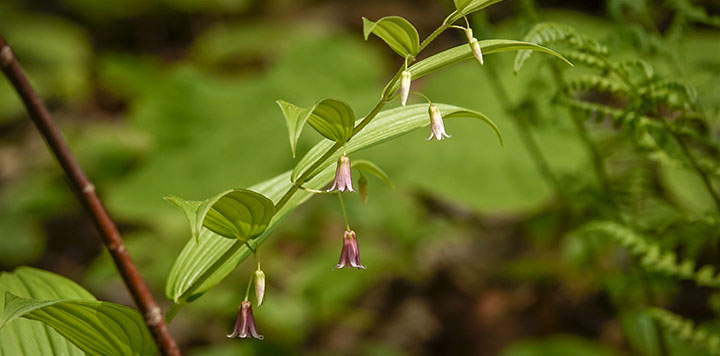
Rose Twisted Stalk (Streptopus lanceolatus) is an understory perennial plant that grows mainly in mixed woods forests. Its small, bell-shaped, rosy flowers appear in late May and early June in the Adirondacks.
Rose Twisted Stalk is a member of the Lily family (Liliaceae) – a family which also includes Clintonia, Indian Cucumber-root, and Trout Lily.
Rose Twisted Stalk is a member of the Streptopus genus. The only other member of this genus that occurs in the Adirondack Park is Clasping-leaved Twisted Stalk or White Mandarin (Streptopus amplexifolius).
- The genus name (Streptopus) comes from the Greek word "streptos," meaning twisted, and "pous," meaning foot or stalk. This may be a reference to the fact that the stalks of the flowers are twisted or bent near the middle. It could also be linked to the zig-zag nature of the plant's stem.
- The species name (lanceolatus) is a reference to the lance-shaped leaves.
Other nonscientific names for Rose Twisted Stalk include Rose Mandarin, Twisted Stalk, Twistedstalk, Lance-leaved Twistedstalk, Rosy Twisted-stalk, Rose Twisted-stalk, Rosybells, Sessile-leaf Twisted-stalk, and Scootberry. The latter name is apparently reference to the fact that the berries can act as a physic, resulting in diarrhea (sometimes called "the scoots").
Identification of Rose Twisted Stalk
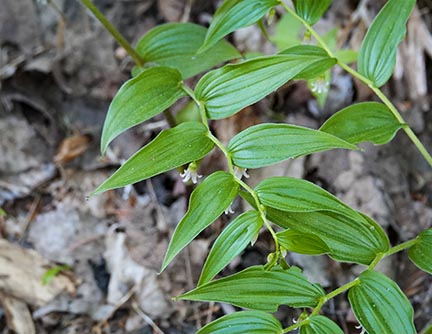
Rose Twisted Stalk plant is one to two feet tall, growing from slender rhizomes Rhizome: The modified subterranean stem of a plant that sends out roots and shoots from its nodes. Rhizomes are also called creeping rootstalks and rootstocks.. The stem has a zig-zag shape (which gives the plant its name) and is slightly hairy, especially along the margins and at the leaf nodes.
Rhizome: The modified subterranean stem of a plant that sends out roots and shoots from its nodes. Rhizomes are also called creeping rootstalks and rootstocks.. The stem has a zig-zag shape (which gives the plant its name) and is slightly hairy, especially along the margins and at the leaf nodes.
The leaves of Rose Twisted Stalk are alternate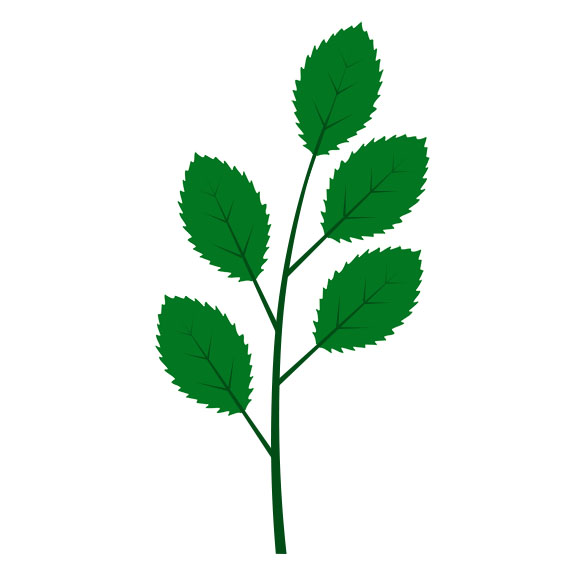 Alternate: An arrangement of leaves (or buds) on a stem (or twig) in which the leaves emerge from the stem one at a time. This often makes the leaves appear to alternate on the stem., meaning they emerge from the stem one at a time, instead of in pairs. The leaves are simple
Alternate: An arrangement of leaves (or buds) on a stem (or twig) in which the leaves emerge from the stem one at a time. This often makes the leaves appear to alternate on the stem., meaning they emerge from the stem one at a time, instead of in pairs. The leaves are simple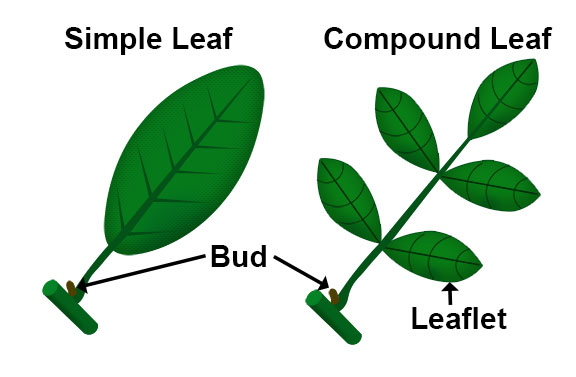 Simple Leaf: A leaf with a single undivided blade, as opposed to a compound leaf, which is one that is divided to the midrib, with distinct, expanded portions called leaflets., meaning that each leaf has a single blade. The leaves are 2½ to six inches long and are lance-like in shape, with narrow pointed tips and a rounded base. The leaves have no leaf stalk. They are seated directly on the stem, slightly clasping it. The marginsThe structure of the leaf's edge. (edges of the leaf) are not toothed
Simple Leaf: A leaf with a single undivided blade, as opposed to a compound leaf, which is one that is divided to the midrib, with distinct, expanded portions called leaflets., meaning that each leaf has a single blade. The leaves are 2½ to six inches long and are lance-like in shape, with narrow pointed tips and a rounded base. The leaves have no leaf stalk. They are seated directly on the stem, slightly clasping it. The marginsThe structure of the leaf's edge. (edges of the leaf) are not toothed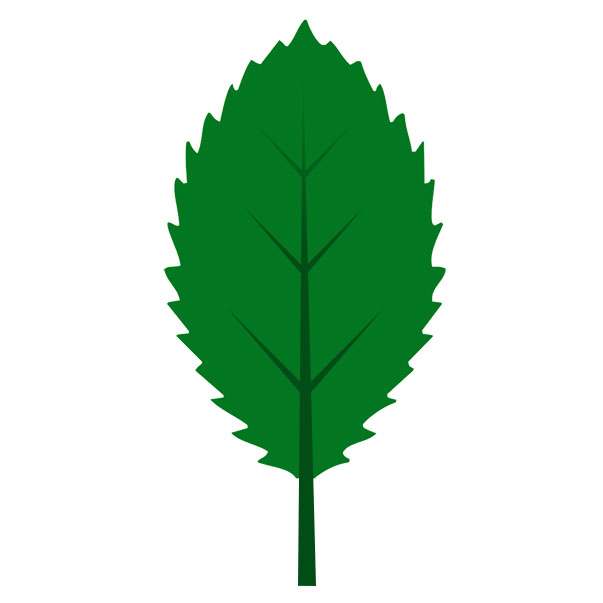 Toothed: Leaves which have a saw-toothed edge. or have very fine teeth. The leaves are fringed with short hairs. The leaves have prominent, parallel veins
Toothed: Leaves which have a saw-toothed edge. or have very fine teeth. The leaves are fringed with short hairs. The leaves have prominent, parallel veins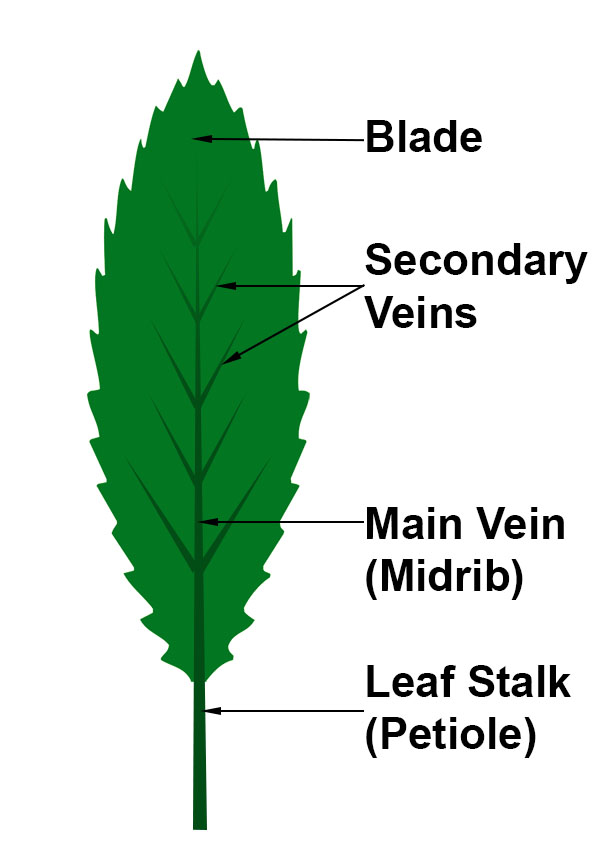 Vein: A vessel that conducts nutrients, sugars, and other substances throughout plant tissues; usually associated with leaves. The arrangement of veins in a leaf is called the venation pattern..
Vein: A vessel that conducts nutrients, sugars, and other substances throughout plant tissues; usually associated with leaves. The arrangement of veins in a leaf is called the venation pattern..
The flowers of Rose Twisted Stalk are tubular and bell-like. The flowers are pink or rose-purple, about 3/8 inch long. Each flower has six petals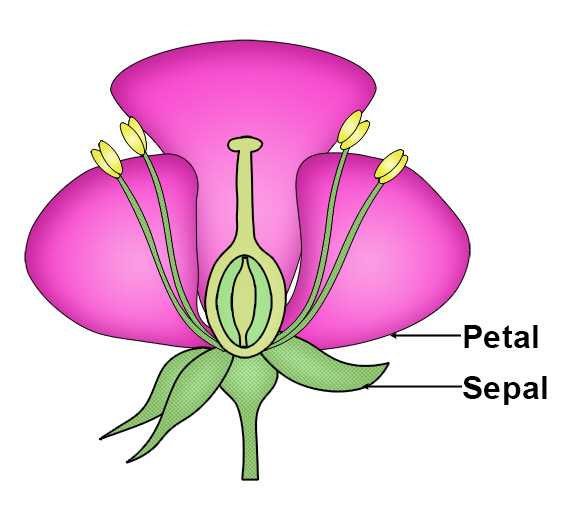 Petals: Modified leaves that surround the reproductive parts of flowers. Petals are often brightly colored or unusually shaped to attract pollinators, each with recurved tips. They hang on slender dangling stalks from the base of the main leaves. The tiny, delicate flowers are usually hidden under the leaves.
Petals: Modified leaves that surround the reproductive parts of flowers. Petals are often brightly colored or unusually shaped to attract pollinators, each with recurved tips. They hang on slender dangling stalks from the base of the main leaves. The tiny, delicate flowers are usually hidden under the leaves.
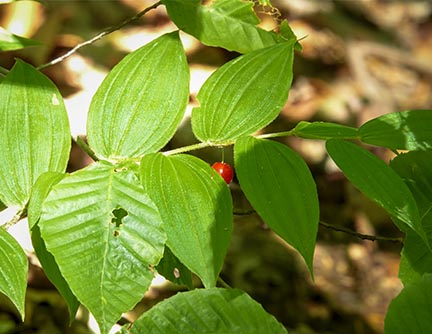
Rose Twisted Stalk usually blooms in May and June. A tally for the upland Adirondack areas compiled by Michael Kudish, based on data collected from the early seventies to the early nineties, lists the median date for flower buds as 22 May. Observations of Rose Twisted Stalk on iNaturalist suggest a similar pattern, with flowers observed in most years from late May to early June.
The flowers of Rose Twisted Stalk are replaced by fruit in the form of rounded, oval berries which hang beneath the plant. The berries are glossy. They are ¼ to 1/3 in diameter and contain many seeds.
The berries start out green and gradually ripen to red or reddish purple in mid-summer. In the Adirondacks, look for glossy, green berries in mid-June to early July, with the berries ripening to a bright red by late July and early August.
Uses of Rose Twisted Stalk
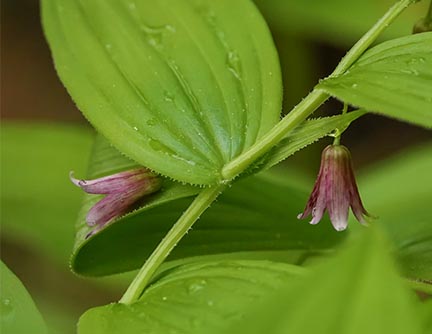
Rose Twisted Stalk has limited uses. Some sources suggest that the fruit, shoots, and leaves of the plant are edible. Shoots and young leaves are said to have a cucumber flavor when added to salads. These parts of the plant, according to some sources, can also be cooked. The fruit, is said to have a sweetish or watermelon flavor. Some sources claim that it can be eaten raw or cooked, but is said to be cathartic if eaten in large quantities.
The plant also is reported to have been used for medicinal purposes. The roots reportedly have been used as a sough syrup. The steeped root of Rose Twisted Stalk has been made into a poultice applied to the eyes. The plant has also also been used as a tonic.
Several Native American groups used the plant in the past as food. The Cherokee, for instance, reportedly ate the young greens. Other groups used the plant to treat a variety of medical conditions, including coughs and eye problems.
Wildlife Value of Rose Twisted Stalk
No wildlife uses could be found for Rose Twisted Stalk.
Distribution of Rose Twisted Stalk
Rose Twisted Stalk occurs from Manitoba east to Newfoundland and south to Georgia, west to Tennessee, and north to Ohio and other mid-western states. It is also found in Alaska south to Oregon.
Within New York State, this plant is found throughout much of eastern half of the state. It is most common in the coolest and more northern parts of the state. A map of Rose Twisted Stalk observations on iNaturalist suggests this plant occurs throughout the Adirondack Park.
Habitat of Rose Twisted Stalk
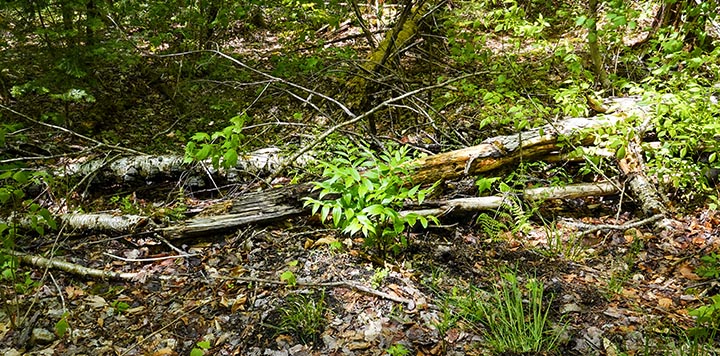
Throughout its range, Rose Twisted Stalk grows in hardwood or mixed conifer-hardwood forests. It usually occurs in non-wetlands, although is also may be found along the borders of swamps. Rose Twisted Stalk is found in several ecological communities including Spruce-Northern Hardwood Forest, Hemlock-Northern Hardwood Forest, and Mountain Fir Forest
Rose Twisted Stalk may be seen along many of the trails covered here, including the Barnum Brook Trail, Henry's Woods Loop Trail, Heaven Hill Trails, the Potato Loop Trail at John Brown Farm, and the Heart Lake Trail.
For instance, in trails that wind through spruce-northern hardwood forests, look for Rose Twisted Stalk growing alongside other plants that flourish in this habitat. The spruce-northern hardwood forest is a mixed forest and one of the most common forest types in the Adirondack region.
- The dominant trees in this habitat are Red Spruce, Sugar Maple, American Beech, Yellow Birch, and Red Maple, with scattered Balsam Fir.
- The most common subcanopy trees are Striped Maple and Mountain Maple.
- Characteristic shrubs include Hobblebush, Canada Yew, and American Fly Honeysuckle.
- Characteristic wildflowers, in addition to Rose Twisted Stalk, include Wild Sarsaparilla, Clintonia, Bunchberry, Canada Mayflower, Indian Cucumber-root, Goldthread, Starflower, and Common Wood Sorrel.
- Characteristic ferns include Hay-scented Fern, Spinulose Wood Fern, and Intermediate Wood Fern.
- Characteristic birds include White-throated Sparrow, Golden-crowned Kinglet, Pileated Woodpecker, and Canada Jay.
References
Michael Kudish. Adirondack Upland Flora: An Ecological Perspective (The Chauncy Press, 1992), p. 231.
New York Flora Association. Rose Twisted Stalk. Streptopus lanceolatus. Retrieved 29 March 2022.
New York Flora Association. Clasping-leavedTwisted Stalk. Streptopus amplexifolius. Retrieved 29 March 2022.
Integrated Taxonomic Information System. Streptopus lanceolatus. Retrieved 29 March 2022.
United States Department of Agriculture. The Plants Database. Twistedstalk. Streptopus lanceolatus. Retrieved 29 March 2022.
Flora of North America. Streptopus lanceolatus. Retrieved 29 March 2022.
NatureServe Explorer. Rosy Twisted-stalk. Streptopus lanceolatus. Retrieved 29 March 2022.
Native Plant Trust. Go Botany. Lance-leaved Twistedstalk. Streptopus lanceolatus. Retrieved 29 March 2022.
Native Plant Trust. Go Botany. Clasping-leaved Twistedstalk. Streptopus amplexifolius. Retrieved 29 March 2022.
New York State. Department of Environmental Conservation. New York Natural Heritage Program. Ecological Communities of New York State. Second Edition (March 2014), pp. 121, 123. Retrieved 17 October 2015.
New York Natural Heritage Program. 2022. Online Conservation Guide for Hemlock-Northern Hardwood Forest. Retrieved 24 November 2022.
New York Natural Heritage Program. 2022. Online Conservation Guide for Mountain Fir Forest. Retrieved 24 November 2022.
New York Natural Heritage Program. 2022. Online Conservation Guide for Spruce-Northern Hardwood Forest. Retrieved 24 November 2022.
New York State. Adirondack Park Agency. Preliminary List of Species Native Within the Adirondack Park Listed Alphabetically by Scientific Name and Sorted by Habit. Volume 1. Updated 10.23.2006, p. 38. Retrieved 26 January 2017.
Elizabeth H. Thompson and Eric R. Sorenson. Wetland, Woodland, Wildland: A Guide to the Natural Communities of Vermont (University Press of New England, 2000), pp. 136-137. Retrieved 29 March 2022.
Connecticut Botanical Society. Rose Twisted-stalk. Streptopus lanceolatus (Ait.) Reveal. Retrieved 29 March 2022.
University of Wisconsin. Flora of Wisconsin. Twisted-stalk. Streptopus lanceolatus. Retrieved 29 March 2022.
Minnesota Wildflowers. Rose Twisted-stalk. Streptopus lanceolatus. Retrieved 29 March 2022.
Lady Bird Johnson Wildflower Center. Twistedstalk. Streptopus lanceolatus. Retrieved 29 March 2022.
iNaturalist. Rose Twisted-Stalk. Streptopus lanceolatus. Retrieved 24 November 2022.
iNaturalist. Adirondack Park Observations. Rose Twisted-Stalk. Streptopus lanceolatus. Retrieved 24 November 2022.
Donald J. Leopold and Lytton John Musselman. Wildflowers of the Adirondacks (Johns Hopkins University Press, 2020), pp. 41-49, 192-193.
Anne McGrath. Wildflowers of the Adirondacks (EarthWords, 2000), p. 26, Plate 13. Retrieved 29 March 2022.
Roger Tory Peterson and Margaret McKenny. A Field Guide to Wildflowers. Northeastern and North-central North America (Houghton Mifflin Company, 1996), pp. 254-255. Retrieved 29 March 2022.
Doug Ladd. North Woods Wildflowers (Falcon Publishing, 2001), p. 83.
Lawrence Newcomb. Newcomb's Wildflower Guide (Little Brown and Company, 1977), pp. 342-343.
Timothy Coffey. The History and Folklore of North American Wildflowers (FactsOnFile, 1993), p. 310. Retrieved 29 March 2022.
William Carey Grimm. The Illustrated Book of Wildflowers and Shrubs (Stackpole Books, 1993), pp. 54-55. Retrieved 29 March 2022.
National Audubon Society. Field Guide to North American Wildflowers. Eastern Region (Alfred A. Knopf, 2001), p. 613, Plate 464. Retrieved 24 November 2022.
William K. Chapman et al. Wildflowers of New York in Color (Syracuse University Press, 1998), pp. 60-61.
Gary Wade et al. Vascular Plant Species of the Forest Ecology Research and Demonstration Area, Paul Smiths, New York. USDA Forest Service. Research Note NE-380, p. 4. Retrieved 22 January 2017.
Mark J. Twery, et al. Changes in Abundance of Vascular Plants under Varying Silvicultural Systems at the Forest Ecosystem Research and Demonstration Area, Paul Smiths, New York. USDA Forest Service. Research Note NRS-169. Retrieved 22 January 2017, p. 8.
Plants for a Future. Streptopus roseus. Retrieved 29 March 2022.
University of Michigan. Native American Ethnobotany. A Database of Foods, Drugs, Dyes and Fibers of Native American Peoples, Derived from Plants. Streptopus lanceolatus. Retrieved 29 March 2022.
Nancy G. Slack and Allison W. Bell. Adirondack Alpine Summits: An Ecological Field Guide (Adirondack Mountain Club, Inc., 2006), p. 27 .
Steven Clemants and Carol Gracie. Wildflowers in the Field and Forest: A Field Guide to the Northeastern United States (Oxford University Press, 2006), p. 70. Retrieved 24 November 2022.
Charles H. Peck. Plants of North Elba. (Bulletin of the New York State Museum, Volume 6, Number 28, June 1899), p. 132. Retrieved 29 March 2022.
Saratoga Woods and Waterways. Bog Meadow Surprises. 5 May 2017. Retrieved 30 March 2022.
Saratoga Woods and Waterways. Protecting Bog Meadow's Beauties. 24 May 2018. Retrieved 30 March 2022.
Saratoga Woods and Waterways. Surprise Finds Along Bog Meadow Trail. 20 May 2019. Retrieved 30 March 2022.
Saratoga Woods and Waterways. Bog Meadow in Transition. 15 May 2018. Retrieved 30 March 2022.
